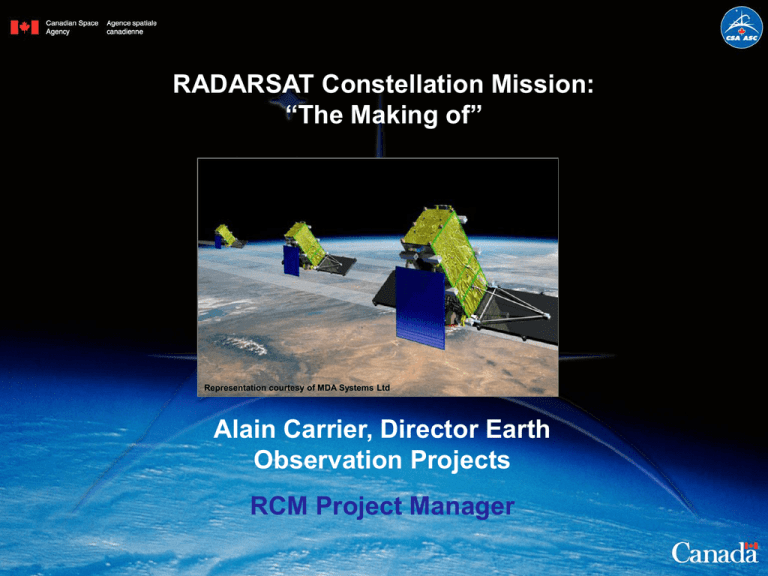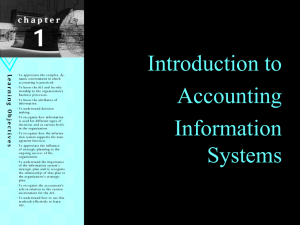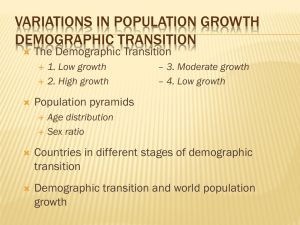System Description
advertisement

RADARSAT Constellation Mission: “The Making of” Representation courtesy of MDA Systems Ltd Alain Carrier, Director Earth Observation Projects RCM Project Manager Outline • Project Description • Design Parameters • Nomenclature and Outcome • System Description • Project Status • Industrial Team 2 Outline • Project Description • Design Parameters • Nomenclature and Outcome • System Description • Project Status • Industrial Team 3 RCM Description • Scalable Constellation of three small SAR1 satellites • Primary objective is to support the operational requirements of Canadian Government departments • Canadian Government-owned and operated • Prime contractor: MDA Systems Ltd (1) Synthetic Aperture Radar 4 RCM Description – Three Segments • Space Segment • Ground Segment Order Handling Three satellites (Bus, SAR Mission Planning payload, AIS) Spacecraft Control Ground support equipment S-band/X-band Grd Terminal (mechanical, electrical) • Launch Segment Reception and Archiving Launch system Launch interface Supporting equipment Product Generation Image Quality Spacecraft Simulator 5 Outline • Project Description • Design Parameters • Nomenclature and Outcome • System Description • Project Status • Industrial Team 6 Design Parameters – Key Drivers • Continuity of C-Band SAR for Operational Users • Improved revisit over wide areas • Responsive Ground Segment (Fast tasking and latency) • Smaller, more cost efficient satellite development • Improved reliability (i.e. redundancy and scalability) • Evolution from RADARSAT-2 to wider Operational use 7 Design Parameters – Mission Requirements • Three satellites with a potential of six • Average daily coverage of Canadian waters and regular land coverage • Average daily global access • Data analyzed in near real time for operational applications RADARSAT Constellation daily coverage • 4-day Coherent Change Detection using SAR interferometry • Gradual implementation with two launches separated by16 months • Gradual replacement of aging satellites RADARSAT-1 or 2 daily coverage 8 Outline • Project Description • Design Parameters • Nomenclature and Outcome • System Description • Project Status • Industrial Team 9 Nomenclature and Outcome– Phases A and B • Phase 0/A – Initiation and Planning • Phase B – Preliminary Definition Opportunity Assessment Detailed requirements flowed down Advanced studies and concept design Risk reduction activities continued Industrial capability establishment Preliminary design cycle completed Critical technology risk reduction Launch environment defined Preliminary cost and schedule estimates Mission Preliminary Design Review Development & confirmation of requirements 10 Nomenclature and Outcome– Phases C and D • Phase C – Detailed Definition • Phase D – Implementation Completes design of all spacecraft elements Manufacturing, AIT1, launch & commissioning of each spacecraft Establishes implementation baseline Design, manufacturing, AIT of ground segment Baseline launch vehicle selected Operations development LLI and associated NRE initiated Training of operations & maintenance personnel Ground segment subsystem requirements established Constellation Commissioning Complete Review Ground segment Preliminary Design Review Mission Critical Design Review 11 (1) Assembly, Integration & Test Nomenclature and Outcome– Phase C Milestones • Payload Critical Design Review • AIT Dev Plan Ops Development Ops Dev Review Draft LEOP plan and Rehearsal plan Bus Critical Design Review SW CDR Power Distribution Unit CDR T/R module CDR Payload Electrical Model complete Antenna CDR Tile Controller CDR Payload Controller Unit CDR Central Electronic Unit CDR AIS PDR Mission AIT Planning • • • Power CDR Attitude Determination & Ctrl Syst. CDR Power Control Unit Qual. Status Review Propulsion CDR MGSE CDR SW CDR Command & Data Handling QSR Thermal CDR Communication CDR Structural CDR Harness CDR Ground Segment Development GS PDR SIM PDR SCS PDR System Requirements Review for: Restoration & Archiving / Product Generation / Image Quality subsystems Order Handling / Mission Planning subsystem Mission Critical Design Review Nomenclature and Outcome– Phase D Milestones • Ground Segment Final Acceptance Review • Bus, Payload & S/C Test Readiness Review • Manufacturing Readiness Review • Mission Preliminary Acceptance Review • Operations Readiness Review • Flight Readiness Review • Commissioning Complete Review – Proto-Flight Model • Commissioning Complete Review (Flight Model 1, Flight Model 2) • Constellation Commissioning Complete Review 13 Nomenclature and Deliverables – Sequencing Launch 1 Launch 2 14 Phase C Phase C Milestones Outline • Project Description • Design Parameters • Nomenclature and Outcome • System Description • Project Status • Industrial Team 16 System Description – Specifications Bus Canadian Smallsat Bus Launcher Falcon 9 specifications (for design) can use PSLV, DNEPR Total Mass 1400 kg Antenna 9.45m2 Power <1600 W peak; <220 W average Orbit 600 km, 100m radius orbital tube Polarisation Single Pol / Dual cross selectable pol & Compact polarimetry available on all modes; One fully polarimetric mode Imaging Time 12 minutes/orbit (peak 20 minutes every three orbits) 10 minutes continuous imaging Lifetime 7 years (each satellite) 17 Drawing courtesy of MDA Systems Ltd Bus Description – RCM Bus Pictures courtesy of Industrial team GPS Reaction Wheel Sun Sensor Magnetometer Battery Star Tracker Power Control Unit Torque Rod N2 S-Band Antenna S-Band Transponder System Description – RCM Payload Representations courtesy of Industrial team Power Distribution Unit Tx/Rx Module SAR Antenna Tile Controller Unit Payload Controller Unit Mass Memory Unit N2 Central Electronic Unit AIS System Description – Ground Segment Baseline St-Hubert (X+S), Svalbard (X+S), Masstown and Aldergrove (X) 20 Outline • Project Description • Design Parameters • Nomenclature and Outcome • System Description • Project Status • Industrial Team 21 Project Status – Schedule and Cost Distribution Y1 Y2 Y3 Y4 Y5 Y6 Y7 Y8 Y9 Y10 Y11 Y12 Phase A Phase B Phase D Now Ops Phase 22 N Y13 Y14 Y15 Outline • Project Description • Design Parameters • Nomenclature and Outcome • System Description • Project Status • Industrial Team 23 Industrial Team 24 Industrial Team – Contract Arrangement & Control • Typical contract structures: Cost reimbursable (Progress payments) Firm Fix Price (Milestone payments) • Canadian content • Regional distribution • Earned Value Management 25 N Back Up RCM Description – Primary Objective • Support the operational requirements of Canadian Government departments in the delivery of services to Canadians in areas of : • Maritime surveillance • Ecosystem monitoring • Disaster management N System Description – Spacecraft 28 N System Description – Spacecraft Exterior Layout System Description – Security Level • • • • High-grade crypto on-board the satellites (Crypto Flight Unit) and on the ground (Crypto Ground Unit) to encrypt all commands and telemetry as well as classified science data (as needed) RCM will be capable of handling both classified and unclassified Orders and Products Unclassified science data will be encrypted to a lesser level (commercial grade) Crypto Ground Units will encrypt commands originating from the CSA operations center as well as decrypt classified and unclassified telemetry and science data Representations courtesy of Industrial team Crypto Flight Unit Crypto Ground Unit 30 Payload Description – Automatic Identification of Ship (AIS) • An additional payload is being considered to receive AIS signal • Would allow real time coherent acquisition of AIS signal with SAR image to identify vessels of interest. 31 Payload Description – Model Philosophy of Main Units 32 Bus Description – Model Philosophy of Bus Ssyst/Unit 33 RCM Description – System Diagram 1 (1) SXGT: S/X Band Ground Terminal 34 Roles & Responsibilities – PMO Level Integration • Project Management – – – – – – – – – – Schedule, Cost, Risks Technical progress & integration (Space & Ground) Implementation analysis Intellectual Property Mission Management Data Policy Data Utilization Application Development Commercialization License Governance (Approval and Reporting) 35 35 Project Status – Requirements Evolution 36 [SYS2010] Imaging Time Per Orbit. Each spacecraft in the system shall be capable of imaging at any time when all of the following constraints are satisfied: 1.No more than 36 minutes of imaging in any moving window time period of duration equal to three orbital periods. 2.No more than 20 minutes of imaging in any moving window time period of duration equal to one orbital period. 3.No more than 10 minutes of imaging in any moving window time period of duration 20 minutes. 4.The spacecraft is not in eclipse. [SYS3100] AIS Operating Time Per Orbit. Each spacecraft in the system shall be capable of collecting AIS at any time when all of the following constraints are satisfied: 1.No more than 51 minutes of AIS collection in any moving window time period of duration equal to three orbital periods. 2.No more than 25 minutes of AIS collection in any moving window time period of duration equal to one orbital period. 3.No more than 15 minutes of AIS collection in any moving window time period of duration 25 minutes.






